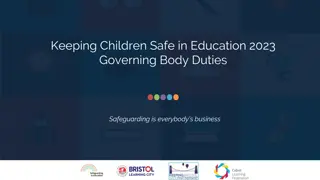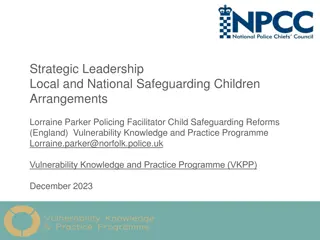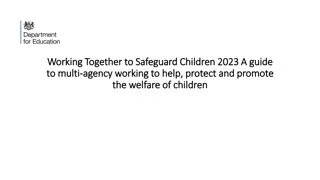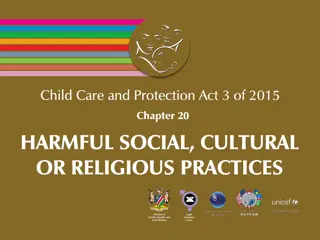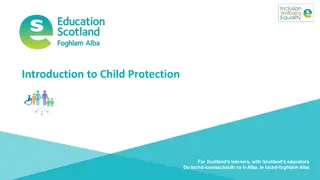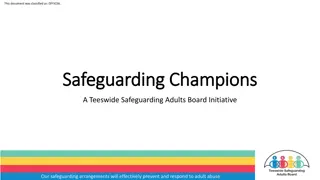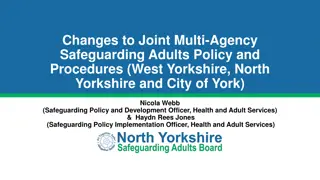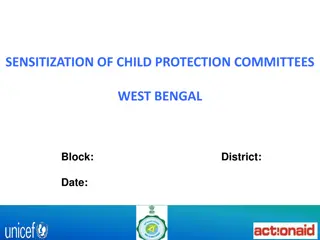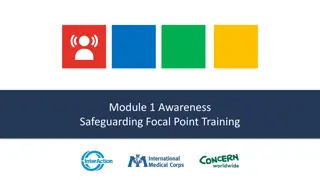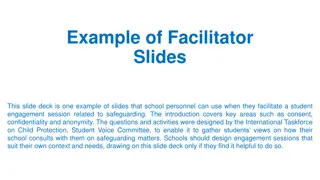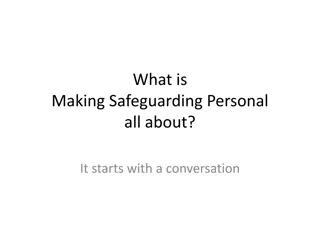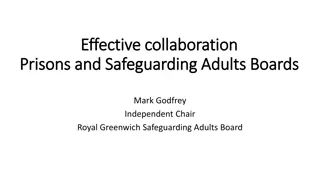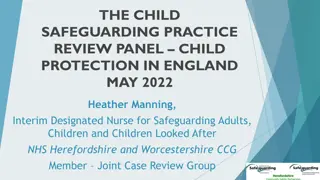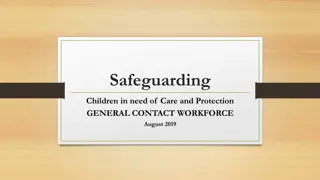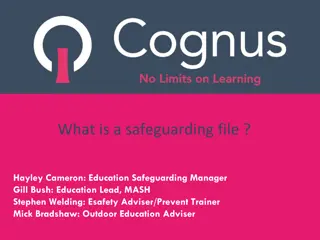Understanding Safeguarding Children and Child Protection
Safeguarding children involves taking proactive measures to promote their well-being and protect them from harm, including abuse and neglect. Child protection focuses on identifying and responding to children who are at risk of significant harm. Different types of harm, such as physical, sexual, emotional, and financial abuse, can have detrimental effects on a child's health and development. It is essential to understand these concepts to ensure children grow up in safe and nurturing environments.
Download Presentation

Please find below an Image/Link to download the presentation.
The content on the website is provided AS IS for your information and personal use only. It may not be sold, licensed, or shared on other websites without obtaining consent from the author. Download presentation by click this link. If you encounter any issues during the download, it is possible that the publisher has removed the file from their server.
E N D
Presentation Transcript
Definitions Key definitions about safeguarding children
Safeguarding Taking action to promote the welfare of children and protect them from harm protecting children from abuse and harm preventing harm to children s health or development taking action to support children and young people to have the best outcomes ensuring children grow up with safe and effective care
Child protection Part of safeguarding and promoting welfare Focuses on protecting children identified as suffering or likely to suffer significant harm This includes child protection procedures which describe how to respond to concerns about a child
Child The Social Services and Well-being (Wales) Act 2014 and accompanying guidance define a child as a person who is aged under 18
Child at risk A child who: is experiencing or is at risk of experiencing abuse, neglect or other kinds of harm and has care and support needs (whether or not the local authority is meeting those needs)
Harm Abuse sexual, emotional, physical, financial and neglect Harming health physical or mental (including seeing or hearing another person suffer abuse) Harming development physical, intellectual, emotional, social or behavioural (including seeing or hearing another person suffer abuse)
Significant harm You determine significant harm by comparing the child s health or development with that which you could reasonably expect of a similar child
Abuse Physical, sexual, emotional or financial abuse Includes abuse in any setting, including a private home, an institution or any other place Includes any harm to the child's health or development through witnessing another person being abused
Abuse Abuse and neglect may be a specific incident or ongoing or repeated abuse and neglect The harm may be caused by a single issue or an accumulation of family circumstances and events The task is to identify how identified risks come together and impact on the parents ability, and the health and well-being of the child
Physical abuse Physical abuse means deliberately hurting a child or young person Fabricating or inducing illness When a carer actively promotes a child s sickness by exaggerating it, not treating real problems, fabricating (lying) or falsifying signs, and/or deliberately making them ill
Sexual abuse Forcing or persuading a child to take part in sexual activities, whether or not the child is aware of what is happening Two categories of sexual abuse: Contact involves touching, where an abuser makes physical contact with a child, including penetration Non-contact non-touching activities, such as grooming, exploitation, persuading children to perform sexual acts over the internet and flashing
Child neglect Child neglect is when the parent or main caregiver doesn t perform parenting tasks to meet the developmental needs of the child Neglect can occur despite the parent/carer having reasonable resources to complete the parenting tasks to a good enough standard Note: If a practitioner suspects neglect, they do not need to satisfy both points ie, do not need to know if the resources are/aren t available they should make a report regardless
Neglectful parenting Medical neglect not seeking and providing appropriate medical, dental and eye care Nutritional neglect not paying attention to the diet for the child who may become obese or fail to thrive (not meeting developmental milestones) Educational neglect not providing an environment for child to achieve their potential Supervisory neglect not providing guidance and supervision that ensures the child is safe and protected from harm
Neglectful parenting Physical neglect not providing physical care appropriate to the child s age and development, and/or a safe physical environment that meets their health and development needs Identity neglect not recognising or addressing the child or young person s needs in terms of culture, religion, gender and sexuality
Emotional abuse / neglect Emotional abuse The ongoing emotional abuse of a child (sometimes called psychological abuse), including deliberately trying to scare or humiliate a child, or isolating or ignoring them Emotional neglect It also includes not saying anything kind, expressing positive feelings or congratulating a child on successes, not showing any emotions in interactions with a child
Financial abuse Includes: stealing money/personal property defrauding the child not meeting their care and support needs which are provided through allowances/grants putting the child under pressure because of money or other personal property
Domestic abuse incident or pattern of incidents of controlling, coercive or threatening behaviour, violence or abuse between those aged 16 or over who are or have been intimate partners or familymembers regardless of gender or sexuality Practitioners might meet a parent or child where they think domestic abuse is present. If you discuss the case with a manager and/or safeguarding lead and you don't think it is a child at risk case, youshould still offer support
Peer relationship abuse A pattern of actual or threatened acts of physical, sexual, and / or emotional abuse, by an adolescent (between the ages of 13 and 16) against a current or former partner Practitioners should treat perpetrator and victim as children who may have care and support needs, and professionals should bear in mind that a child may be both a perpetrator and a victim of violence
Child criminal exploitation (CCE) Involving children in criminal activities including moving drugs or money for the profit of an individual, group or an organised criminal gang Involves an element of exchange and is exploitation even if the activity appears consensual Can involve force and/or enticement and is often accompanied by violence or threats of violence. Typically has power imbalance in favour of those who are exploiting the child
Honour-based abuse Abuse and/or violence committed by people for behaviours which are against the family s or community s expectations, such as: refusing to marry, adultery, divorce being LGBT+ being a victim of rape or sexual assault wearing makeup, dressing inappropriately wanting a career
Online abuse Any type of abuse through technology, such as computers, tablets, mobile phones, consoles and other electronic devices Grooming Cyberbullying/Abusive online behaviour between children Sexting and sexual harassment Online pornography Sexual abuse online Online radicalisation
Child trafficking Includes three elements: 1) involves a child 2) movement from one place to another 3) for the purpose of exploitation Any child who has been recruited, transported, transferred, harboured or received for the purpose of exploitation must be considered a victim of trafficking and/or modern slavery, whether or not they have been forced or deceived
Child sexual exploitation (CSE) Includes three elements: 1) involves a child 2) is a form of sexual abuse 3) involves some form of exchange The involvement of exchange is what makes CSE distinct from other forms of child sexual abuse Grooming, coercion and control are often employed by perpetrators and facilitators of CSE as ways to get children into a position to be abused and/or to ensure that children engage in sexual acts



